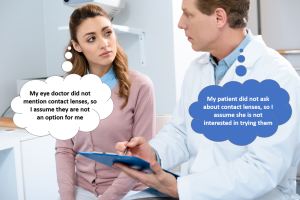
Who is the most valuable patient in your practice? We all know how important our spectacle wearers are, but our contact lens patients tend to return more often for their exams, and overall tend to spend more.1 We often go on auto-pilot with our contact lens patients, especially our “happy patients”- why rock the boat if they are not complaining? However, with an average of 16% of contact lens wearers dropping out during the year,2 we need to pay careful attention to these patients. With the abundance of contact lens technology and dry eye diagnostics and treatment available, we have every ability to keep these patients happy in their contact lenses. By reducing contact lens dropout, we can effectively increase profitability in our practice- without seeing more patients!
Ask The Right Questions
Contact lens wearers live in fear that we are going to tell them they can’t wear lenses anymore. So, if they are finding their lenses are less comfortable, they start to wear them less. They may not completely drop out, but they may become a part time wearer (which I also consider a form of drop out). When we ask a patient “how are your contact lenses?”, their knee jerk reaction is to say, “they are fine!” because they do not want to tell us they are uncomfortable for fear we will tell them they can’t wear them any longer. We also assume a patient who is not complaining is a happy patient, which also can be untrue.
So, what questions should we ask instead? I like asking a patient “if there is one thing you could change about your contacts, what would that be?” Or, “I know you are doing well, but how could I make your contacts even better?” This open-ended series of questions acknowledges that the patient is likely doing ok, but may be starting to find things that may contribute to drop out. This is a great opportunity for a conversation about new technologies (silicone hydrogel lenses, daily disposable lenses) or modalities (multifocal). This patient led discussion can make a conversion to a more expensive, newer lens more comfortable for doctors too- it doesn’t feel as much as a “sell” to patients if they are the ones driving the change. A great introduction could be “Mrs Smith, you mentioned your lenses are less comfortable at the end of the day. I am going to refit you with the MyDay® contact lens, which will give you all day comfort and is very breathable.”3
It can be difficult to remember all of these questions in the exam room, in addition to all of the other parts of an exam and discussion we need to cover. I made this conversation part of my mental checklist that I go through with every single contact lens patient- it takes practice, but it is well worth it.
Embrace New Technology
As we alluded to in the previous section, taking advantage of technology is a great way to prevent contact lens dropout. One of the largest segments of patients I see that discontinue wear are presbyopic patients. These patients may have been contact lens wearers for decades but find the addition of reading glasses over contact lenses to be frustrating. They often opt to go to full time spectacle wear not because they want to, but often because they think it is their only option. Doctors often let this slide, because multifocal patients can be chair time intensive and we may falsely assume these patients do not want to try.
How can we combat this? Assume every presbyopic contact lens patient (or every patient in general!) is interested in multifocal contact lens wear. Making this part of your exam checklist will help to remember to bring it up in the exam room. For patients with presbyopia, I’ve found clariti® 1 day multifocal 3 Add simple to prescribe and requiring less chair time to fit than other designs I’ve prescribed in the past.4 Additionally, I’ve experienced a smooth refit when transitioning my 2 Add wearers into the new 3 Add design, which now offers patients an upgrade with CooperVision Binocular Progressive System ™, also found in MyDay® multifocal.*5
The Binocular Progressive System’s™ familiar fitting process and fit guide offer a streamlined fit approach and assurance of a high fit success rate.6 Additionally, the Binocular Progressive System™ is designed to deliver optimal visual acuity at all distances, even as patients’ presbyopia advances.7 Further, tools such as OptiExpert™ help me to significantly cut down on the number of changes I make to a multifocal prescription and have been more likely to be successful on my first try.†
Patients have been appreciative and excited to have an option to continue contact lens wear as they need near and intermediate vision help. By taking a few extra minutes of time in the exam room for discussion and to set expectations, you can continue to reap the benefits of happy contact lens patients who continue in lenses and don’t drop out.
Dropout Can Be Gradual
“Hi Mrs. Jones, it looks like you last ordered an annual supply of contact lenses 2 years ago- is everything going well with your contacts?” “Oh yes Dr Stewart, I just have been wearing them on weekends lately, instead of all week. I’ve been wearing my glasses to work.” While this patient hasn’t discontinued contact lens wear completely, I consider this patient a “drop out”. Noticing that patients are ordering contact lenses less frequently (and in turn, having exams less frequently) is a great time to step in, ask good, open ended questions, and turn their experience around. If you can catch this patient before they drop out, you are more likely to help them then after they have fully stopped contact lens wear completely. Pay attention to frequency of orders, and frequency of exams. This is a great opportunity to change their contact lens experience!
Treat the Source
We know that dry eye is extremely prevalent in our patients. According to the AOA, more that 11.1 million women and 5.3 million men have been diagnosed with dry eye disease.8 Even more shocking is that an estimated 6 million people have DED symptoms but have not been diagnosed.8 These patients are the ones who are likely to gradually phase out their contact lens wear and eventually drop out, as they don’t realize what the cause is.
We are fortunate to have great tools available to use in testing, evaluation, and treatment of dry eye disease. We should be carefully screening all our patients, especially contact lens wearers, for any signs or symptoms of DED. We should swiftly begin treatment and education, so these patients understand the underlying conditions, the chronicity of the disease, and how this affects their contact lens wearing experience. By effectively managing their DED, we can keep their symptoms under control, and keep them in their contact lenses.
Contact lens patients are extremely important in our practices. They can be extremely profitable, but when they start to drop out of contact lens wear, this can have a huge effect on our practice bottom line. By taking a few extra minutes in each exam to ask good questions, provide the latest in technology, and treat underlying conditions, we can keep these patients happily wearing contact lenses for years.

Jennifer Stewart, OD is the founder of Look New Canaan, a boutique optometric private practice located in New Canaan, CT. She is also the founder and Chief Vision Officer for OD Perspectives, an advisory and consulting firm in the eyecare industry. She can be contacted at jennifer.stewart@odperspectives.com.








